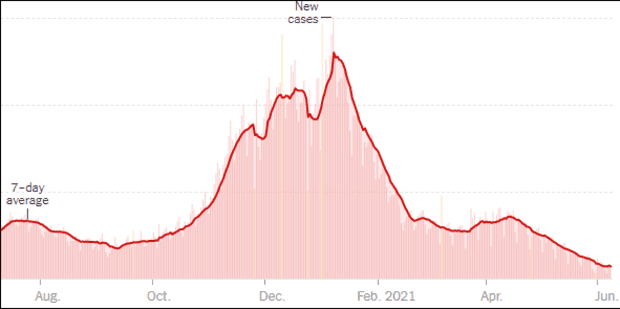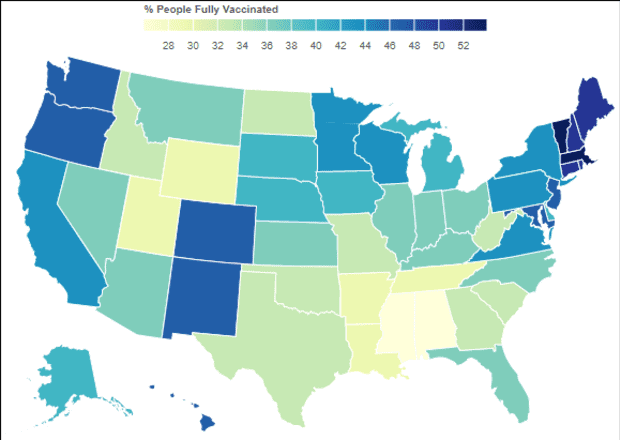This post was originally published on this site
The number of new daily COVID-19 cases and deaths rose for a second straight day, as concerns over the more easily transmissible delta variant increase, and as continued vaccination hesitancy puts meeting President Biden’s goal for July 4 at risk.
The number of new cases of the coronavirus-borne illness rose to 15,048 on Tuesday from 13,758 on Monday, which was up from 6,067 cases on Sunday, according to a New York Times tracker.
Meanwhile, the data showed that the seven-day average slipped to 14,031 on Tuesday, after ticking up to 15,107 on Monday from 13,935 on Sunday. Tuesday’s seven-day average was down 42% from two weeks ago.

New reported daily COVID-19 cases
New York Times
New daily deaths grew to 373 on Tuesday, from 305 on Monday and 253 on Sunday, while the seven-day averaged slipped to 438 from Monday’s 459, and was 20% below where it was two weeks ago.
On the bright side, the number of states that have seen the weekly trend of new cases rise this week fell to 14, according to data aggregated by Johns Hopkins University, from 22 states on Tuesday.
The White House continued its full-court press to get Americans vaccinated, to meet Biden’s goal of having 70% of the U.S. adult population receiving at least one dose of a COVID-19 vaccine by the Fourth of July. But there are now concerns that the goal will not be reached, as only 14 states have currently met that target with just 25 days to go.
Read the AP story: U.S. unlikely to meet Biden’s goal of 70% vaccinated by July 4.
Dr. Anthony Fauci, Biden’s chief medical adviser, said Tuesday at a White House COVID-19 briefing that “I hope we can — I hope we will” reach the 70% goal.
He said goals are set to “stimulate us to get to that goal,” and efforts to get people vaccinated are not made useless if the they fall a few percentage points short.
That marked a slight change from his comments on Monday, on ABC’s “Live with Kelly and Ryan,” in which Fauci said, “We want to, and we’re going to, hit 70% of the adult population by the Fourth of July.”
Read MarketWatch’s daily Coronavirus Update column.
Another growing worry is the spread of the delta variant (B1617.2.), which was originally noted in India, and of which Fauci has said the “transmissibility appears to be greater than the wild type.” In the U.S., he said Tuesday that the delta variant now accounts for more than 6% of sequenced cases.
He stressed that the U.S. has to avoid what happened in the U.K., where the delta variant is now the “dominant” strain at greater than 60% of cases.
“We cannot let that happen in the United States,” Fauci said, noting that the risk kis a “powerful argument” to get more Americans vaccinated. Fauci pointed out that the two-dose vaccine from Pfizer Inc.
PFE,
and partner BioNTech SE
BNTX,
was 88% effective against delta, two weeks after the second dose.
Now, the good news.
The number of vaccine doses administered rose to 303.92 million, according to the latest data from the Centers for Disease Control and Prevention, with 171.73 million Americans, including 63.8% of the adult population, receiving at least one dose. The number of fully vaccinated Americans increased to 140.44 million, or 42.3% of the total population.
Within age groups, 50.1% of Americans who are at least 12 years old are fully vaccinated, as are 53.1% of the U.S. adult population and 75.6% of Americans at least 65 years old.
In the U.S., fully vaccinated means it has been two weeks since the second of the two-dose vaccines developed by Pfizer with BioNTech or Moderna Inc.
MRNA,
have been administered, or it’s been two weeks since receiving the lone dose of Johnson & Johnson’s
JNJ,
vaccine.
Currently just three states — Vermont (53.9%), Massachusetts (52.9%) and Connecticut (50.8%) — have more than half of their complete populations fully vaccinated, and 16 states and the District of Columbia have fully vaccinated more than the U.S. average, according to JHU data. The states with the lowest percentage of their populations fully vaccinated are Mississippi (26.1%), Alabama (27.5%) and Louisiana (29.6%).

Johns Hopkins University & Medicine
The weekly average of people hospitalized with COVID-19 was 22,158 on Tuesday, down from 22,445 on Monday, and 22% below the average from two weeks ago.
Earlier Wednesday, Merck & Co.
MRK,
announced a $1.2 billion supply agreement with the U.S. government for molnupiravir, its investigational oral antiviral candidate developed in collaboration with Ridgeback Biotherapeutics to treat mild to moderate COVID-19.
Molnupiravir is currently undergoing a Phase 3 clinical trial for treating COVID-19 in nonhospitalized patients with at least one risk factor. If molnupiravir is granted emergency-use authorization by the Food and Drug Administration, Merck will receive about $1.2 billion to supply the government with 1.7 million courses of the therapy.
And the Biden administration will buy 500 million more doses of the Pfizer-BioNTech COVID-19 vaccine, and then donate them to 92 lower income countries and the African Union over the next year, according to an Associated Press report.
Latest tallies
The global case tally for the coronavirus-borne illness rose to 174.14 million on Wednesday, while the death toll rose to 3,750,423, according to JHU data. There have been 2.21 million vaccine doses administered, the data show.
The U.S. leads the world in total cases with 33.40 million and deaths with 598,580.
India continues to move closer to the U.S., with 29.09 million cases, but is third in the world in deaths with 353,528.
Brazil is second in deaths at 476,792 and third in cases with 17.04 million.
The U.K. is fourth in deaths worldwide, and it leads Europe in deaths at 28,124, while France leads Europe in cases with 5.79 million.
China, where the virus was first discovered late in 2019, has had 103,239 cases and 4,846 deaths, according to its official numbers, which are widely held to be massively underreported.

